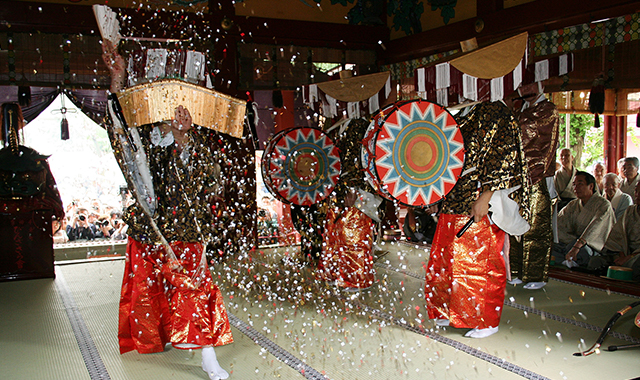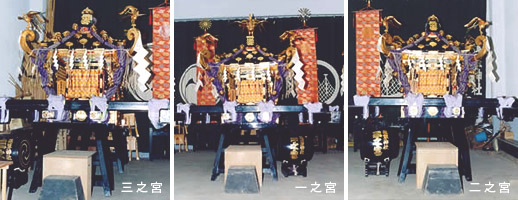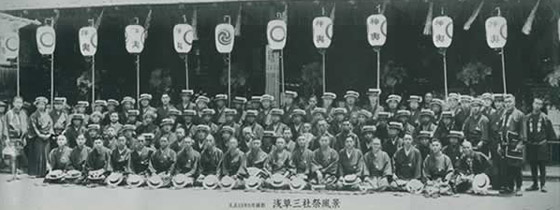Sanjamatsuri ?
浅草神社の氏子四十四ヶ町を中心に五月の第三土曜日を基点とした金・土・日曜日に行われ、江戸風情を残しつつ勇壮且つ華やかな神輿渡御を主として、三日間に亘り約百八十万人の人出を数える日本を代表する祭礼の一つです。
江戸風情の残る下町浅草が1年でもっとも活気付くと云われ、東京の初夏を代表する風物詩の一つになっています。
On the first day, the "Great Matrix" organized with music stalls, Maiko woodworking, Asakusa dances, Geiko-bunko gaiko dance and group dances, for example, marked the beginning of the festival in the Asakusa Town, the Tokyo Metropolitan Intangible Cultural Heritage The designated "Shinto Genkira Mai" will also be dedicated.
On the second day, the "Exceptional Ceremony Ceremony" was launched, after which about "100 mikoshi in the town of Shika Asakusa in the town of Makoto Asakusa gathered in the shrine precincts with a passage of" mikomi association in the town ", and exhort one by one We will accept each town council.
On the last day, as a passage of each of the three shrines of the shrine Mikoshi "Ichinomiya", "Ninomiya" and "Sannomiya", early in the morning shrine "miyuki" is carried out from within the precincts of the shrine, during the day, The festival celebrations will end after welcoming the direction of "entering the temple", returning to the shrine's precincts after sunset.
During the period, the city of Asakusa is colored as a festival, each shrine goes on a shrine, and various dances are also presented in the precincts and Kagura dens.
Shinto shrine Mai Bingasa Mai
 It is Mai Tanaka which is danced Sanjamatsuri as a priest of Asakusa Shrine and is currently designated as an intangible folk cultural property of Tokyo.
It is Mai Tanaka which is danced Sanjamatsuri as a priest of Asakusa Shrine and is currently designated as an intangible folk cultural property of Tokyo.
The rice planting event was made into entertainment, it is scattered red and white paper and it is spreading as a paddy. By playing the sound with the instrument (Sasara), the wish of rich fruit and demonic evacuation is put in, and there is a lion dance We pray for Nagaku descendants and exorcism for illnesses.
About a shrine
A mikoshi is a festival and refers to a mikoshi that a sacred spirit or a priest rides on during the Shinko festival.
Kamiyuki means to bring a shinto body to a traveling place (a place to become a relay point of Godoyuki and a destination). At this time, the mothers will take care of each district by carrying them, but by doing this we see each district to God.

On the way of the Shinki Shrine, swinging a shrine's mushroom up and down, left and right, and shaking roughly shaking on purpose, we performed God 's soul swing (Tamarari) that sits in a shrine mushroom, thereby enhancing the spirit of God, harvesting, It is believed that the devastation of plague will occur.
Asakusa Shrine has three gods, and at the time of the festival, the spirits of Haji Manaka Tomomei to Ichinomiya, Himaehama Narimei to Ninomiya, and Himae Takenari to Sannomiya were transferred to the town. I will hand over.
Shrine Mikoshi
Before the war there were three shrines of mikoshi donated by Ikko Koko and three newly renovated for its preservation, and one group (Shinnonomiya) donated by Shinkochōkai, there were seven mikoshi All the regretfully burned down due to the large air raid of.
The current mikoshi was dedicated by Mrs. Ichinoyonomiya and Ninomiya in 1952 and Sannomiya in Showa 28th year. It is a modern construction where the torso is thin and the roof of the four corners of the roof is big In the head of Ichiyonomiya, phoenix is displayed, and the other two are decorated with imitation jewels.

Taisho in May 2012 shooting
Shikonami

Originally it was a shrine made in Tamachi as a shrine mikoshi. However, because it was too heavy, there were no people to take in the town association and it was dedicated to Asakusa Shrine. In the case of the festival, we transferred the Holy Spirit of Toshogu, and began to be carried as Shimonomiya.
Even if it says heavy, it was lighter and easier to move than the other three shrine mikoshi, so it was said that the clerk deliberately carried it violently, so he seems to have taken the alias of "Rampage Mikoshi".
※ Shimonomiya has been burned down due to war damage.
Old festival (Kannon festival / festival festival)
The festival of the past was held on March 17th and 18th and the festival was held every other year in Ox, Uwa, Mi, Mi, Roi, and Ya.
From the first year of Masakazu (1312) it is said that a festival began based on the myths of the three companies.
On the eve of the Great Big Festival during the Edo period, a shrine was set in the outer court of the Kannon main hall. Mai Bura Mai was also performed on the stage of the maiden. As you can see from that, at that time it was a festival integrated with Asakusa Temple, called "Kannon Festival" or "Asakusa Festival".
There are 18 old towns in the ancient days since the Kannon farewells. From the south, Suwa Town, Komagata Town, Mikama Town, Nishinari Town, Tahara Town, Higashinaka Town, Namiki Town, Chaya Town, Timber Town, Hanakawado Town, Yamanobe It was that town, saint sown town, Asakusa cho, saint sightseeing town, gold dragon yamashita sashimachi, southern Mamdo town, shinmachi, northern village town, Tamachi. Among them, lumber, Hanakawado, and saint are called Miyamoto Mikamachi, and they are collectively referred to as Asakusa Township and Senzako Town as well.
The festival is more like a festival than a head shrine mikoshi as it is now, rather than a mountain car dispatched from Mrs. Hakkacho, Katamachi, Kayama, Tenno Town, Kuroitakecho, Miyoshi cho, etc., each town has its own It seems that competition between the momentum of the queue and the gentleness was felt with the taste of. Like this, the festival of the past was a wide range extending to Kuramae and Asakusabashi towns.
Early in the morning of the festival, festival matrices centered on the floats were assembled outside the gates of Asakusa Mitsuke.
From Mikora to Suwa Town, alongside Namiki Town, enter the precincts from Nakamise, pilgrim in front of a shrine held in Kannondo, play each entertainment, leave the Demon gate (Ben Tianmen) and return to your town It was. When this is over, you will say "Odori" and drop the three shrines from the main hall, and take over to Ichinomiya and take you to the boarding area of Asakusa Gate. It is said to have returned to Asakusa Shrine by rowing the Asakusa River (Sumida river), taking a shrine on the ship serving the fishermen living in Omori who was waiting and landed from Komagata. This festival lasted until the end of Edo. In the Meiji era was abolished, festival was held on May 17th and 18th from Meiji 5, and I began to hand out the mikoshi to each of the current towns.